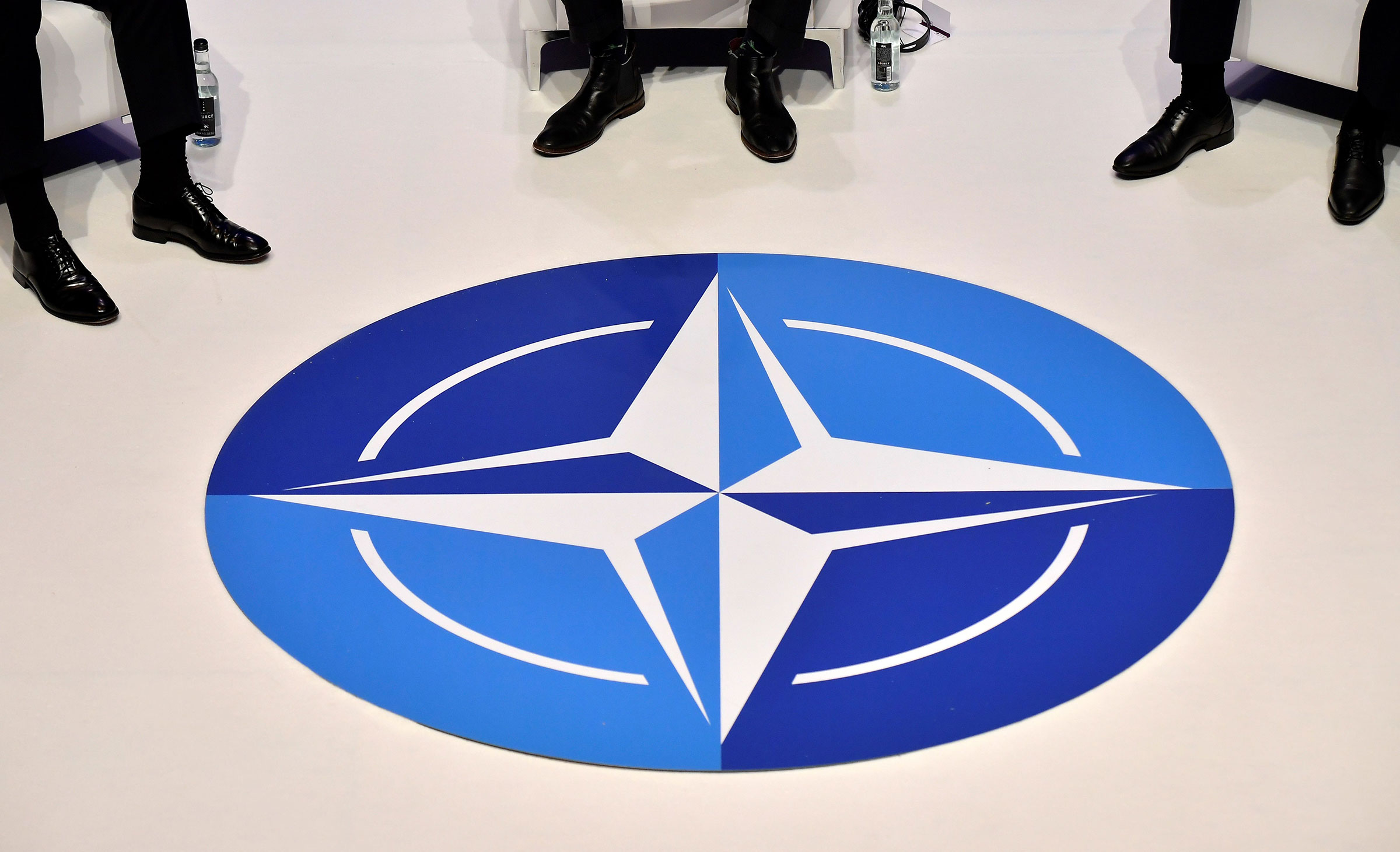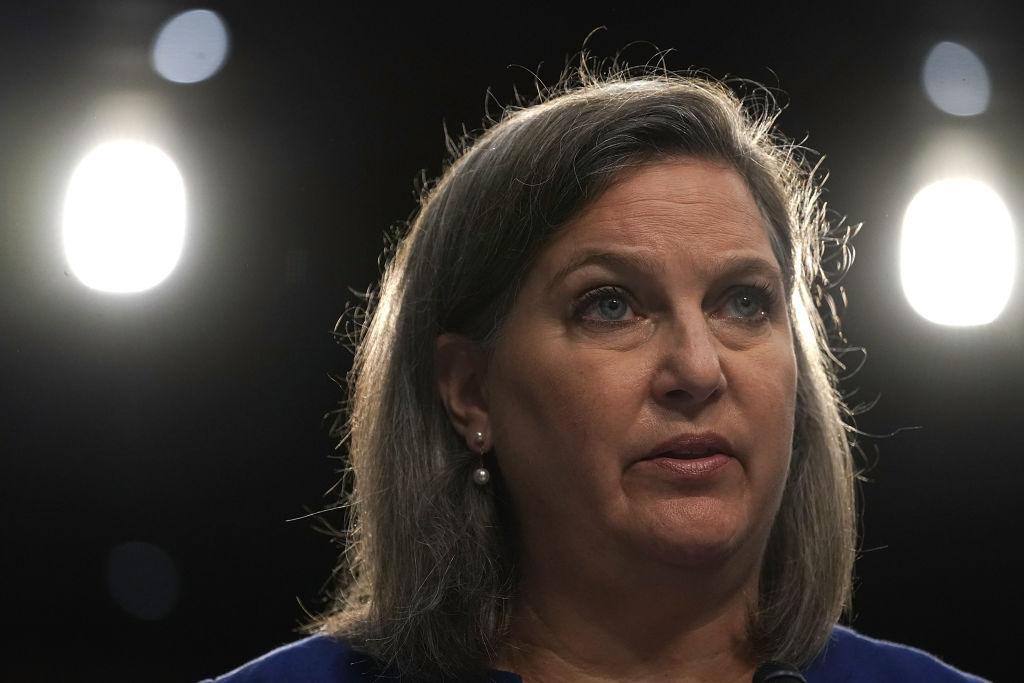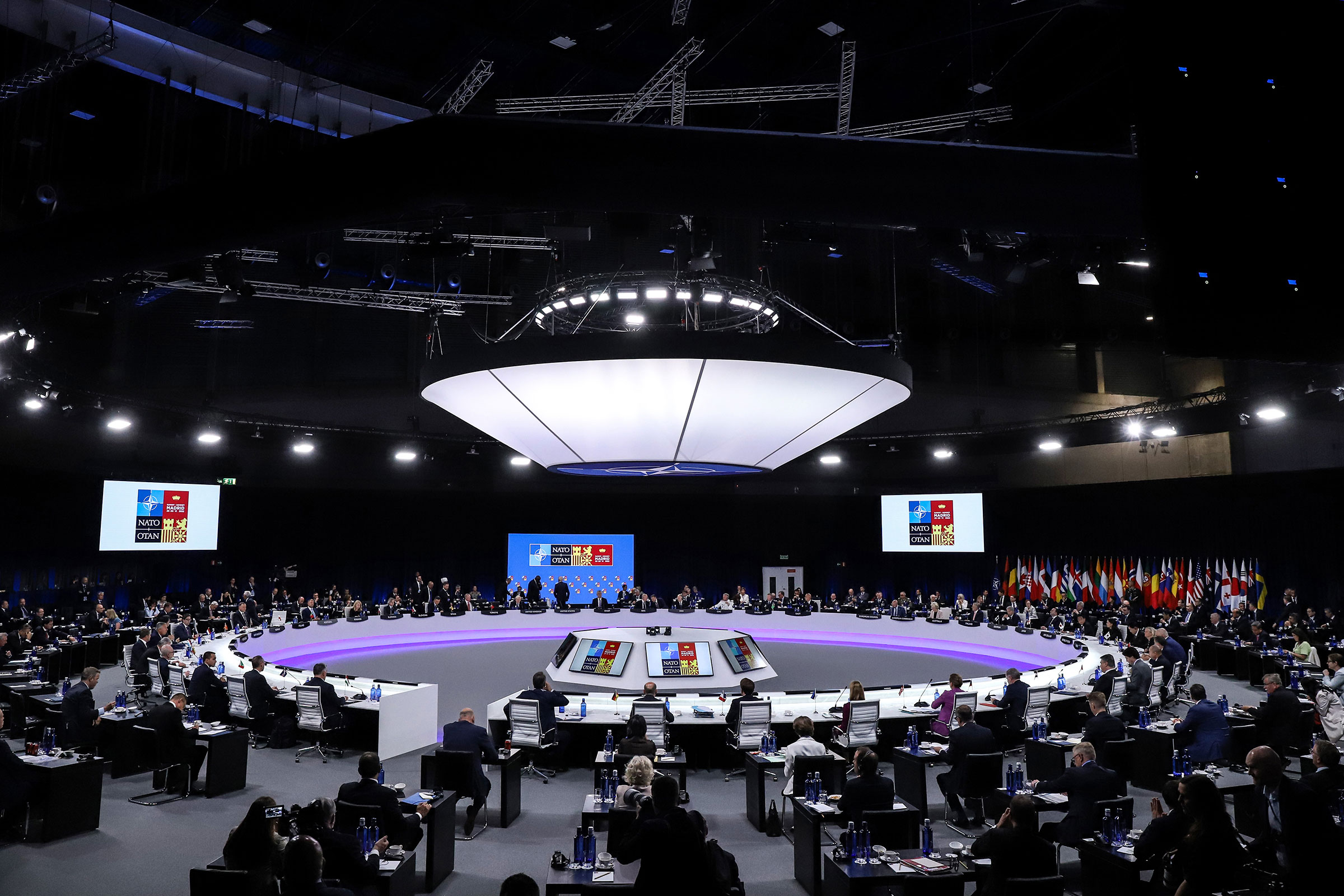
When, in 2019, French President Emmanuel Macron warned NATO risked becoming “braindead,” objections were pro forma rather than passionate. President Donald Trump had just pulled American forces out of northern Syria without consulting the bloc, from which he had repeatedly threatened to withdraw. Fellow NATO member Turkey invaded north-eastern Syria soon after, displacing hundreds of thousands. Speaking with The Economist, Macron expressed serious doubts that NATO’s Article 5—which declares that an attack on one member nation is an attack on all—still applied.
Fast forward a few years and the fate of Europe hinges on NATO more than any time since the fall of the Soviet Union. Even historically neutral nations like Sweden and Finland have applied to join the bloc, seeing Article 5 as their best guarantor of security and sovereignty. At a landmark summit in Madrid on June 28-30, NATO unveiled a new once-in-a-decade Strategic Concept—its broad mission statement—amid a radical beefing up of defenses, raising its Rapid Response Force from 40,000 to more than 300,000 troops. Russia, unsurprisingly, was picked out as “the most significant and direct threat to Allies’ security,” though China—some 3,700 miles from the Atlantic—was also named as a source of “systemic challenges.” On Wednesday, U.S. President Joe Biden also announced increased American troop deployments across Europe. “NATO is strong and united,” Biden said.
Read More: The 2022 NATO Summit Could Be the Most Important in Recent Decades. Here’s Why
It’s a remarkable rebirth spurred by Russian President Vladimir Putin’s Feb. 24 full-scale invasion of Ukraine, which ripped up the international order and put European nations on high alert. But even earlier, NATO’s role had swelled to match Putin’s belligerence. Before he annexed Crimea in 2014, NATO’s eastern members hosted no foreign troops. Afterward, Estonia, Latvia, Lithuania and Poland received small battle groups of around a thousand each to symbolically ensure that any Russian aggression would be against NATO forces, too, thus triggering a full-scale response.
Building on these symbolic deployments, discussions at Madrid involve expanding these defenses into brigades that can actually repel a Russian invasion. NATO is also discussing a comprehensive assistance package to train and equip the Ukrainian Armed Forces. In addition, four new battle groups are being established in Bulgaria, Romania, Hungary and Slovakia, reflecting a growing focus toward the Black Sea region. NATO members collectively are seeing a radical boost of defense spending.
It’s unlikely this is what Putin envisaged when he ordered his tanks into Ukraine. It’s also something of a paradox, since NATO’s expansion in recent years fed Putin’s paranoia, providing a ready excuse to invade a sovereign neighbor. As unjustified as that escalating bloodshed remains, Putin can point to several red lines crossed. Now, the bloc is expanding its remit under U.S. direction to include containing a resurgent China—notably, Japan, South Korea, Australia and New Zealand attended Madrid as observers for the first time. The risk is that past missteps may be repeated yet again: in 1919, after the end of World War I, Hitler leveraged German anger regarding onerous World War I reparations to justify his Third Reich. With Russia already calling the expansion deal “destabilizing,” some wonder whether a more powerful NATO risks cleaving the world into antagonistic factions.
NATO’s shifting mission
NATO was founded amid the Cold War in 1949 by North American and European allies on a basis of mutual military assistance in the event of aggression by the Soviet Union, which had its equivalent Warsaw Pact group of allies. Despite the dissolution of the Soviet Union in 1991, NATO has since undergone five stages of expansion, while engaging in military operations in the Balkans, Middle East, and Africa.
Following the Soviet collapse, NATO and Moscow frequently cooperated. Russia was instrumental in helping NATO negotiate an end to the 1992-1995 Bosnia War and then joined the peace accord implementation force. Still, it’s telling that Russia refused to have its troops serve under NATO Command, instead officially deploying under U.S. Command—a fudge since U.S. General George Joulwan was commander for both.
Read More: Japan and South Korea’s Attendance at the Upcoming NATO Summit Could Worsen Global Tensions
Given its founding mission, Russia always remained suspicious about NATO expansion—especially regarding Ukraine. When NATO was negotiating to admit Czech Republic, Poland and Hungary in 1997, it was made explicitly clear to Russia that Ukraine was “off-limits,” says Robert Hunter, U.S. Ambassador to NATO at the time. “It was fully understood by everybody that Ukraine would not be in NATO. Hence, we had a NATO-Ukraine charter,” which codified the relationship between the bloc and a nation that was always intended to be outside.
Victoria Nuland, current U.S. Undersecretary of State for Political Affairs, had her first meeting with a senior Russian official named Vladimir Putin a year later. “My memory of that first meeting in 1998 [is that] Putin was still in the place of, ‘maybe a different kind of Russia and a different kind of NATO could be aligned,’” she tells TIME.
Several rounds of NATO expansion continued thereafter, during which the Kremlin grumbled but basically bit its teeth. Putin served two terms as President before temporarily handing the reins to his longtime ally, Dmitry Medvedev, who in 2008 proposed a new European Security Treaty into which NATO members and Russia could be subsumed. However, the Bush Administration rejected it wholesale. “I thought [that] was a mistake at the time, frankly,” says Nuland. “We should have just talked, even if it was just to keep the conversation going.”

Hunter is more blunt: “Beginning in 2008, people in power in Washington decided ‘Russia lost the Cold War so screw them,’ which was stupid,” he says. President George W. Bush attended a NATO summit in Bucharest that year proposing an action plan for Ukraine and Georgia to join NATO. Other members were aghast, cognizant of the clear red lines that would cross by including former key Soviet states to NATO. “But to save George Bush from looking stupid when he went home,” says Hunter, they added the phrase: [Ukraine and Georgia] will become NATO members to the summit declaration]. Adds Hunter: “But everybody knew it really meant never.”
Nevertheless, at every NATO summit thereafter, this addendum was repeated like a self-fulling prophecy. “Putin used this for his own purposes,” says Hunter. “But we stupidly played into his hands.
On Nov. 21, 2013, Ukrainians led enormous protests at Maidan Square in Kyiv against the pro-Russian President Viktor Yanukovych’s sudden decision not to sign an association agreement with the E.U., instead choosing closer ties to Moscow. The protests continued for three months. Nuland, then Assistant Secretary of State for European and Eurasian Affairs, was controversially seen glad-handing protesters and even handing them cookies. Then a phone conversation between Nuland and U.S. Ambassador to Ukraine Geoffrey Pyatt, during which the pair discussed preferred candidates for a post-Yanukovych administration, was leaked online, presumably by Russian agents. It led Putin to accuse the U.S. of sponsoring a coup in Ukraine, which he later twisted to justify his annexation of Crimea.
More from TIME
Putin repeated this accusation during the press conference following his summit with U.S. President Joe Biden in Geneva in June 2021. At that meeting, Putin bore the hallmarks of his COVID-19 isolation, say observers. His team arrived on a different airplane, didn’t see him before it started, and complained quite openly to their U.S. counterparts that they didn’t get much briefing time. “So [Putin] was already his own consigliere then,” says one source present.
By November, Russia’s full-scale invasion plans for Ukraine were picked up by U.S. intelligence amid a huge troop build-up on Ukraine’s borders. Nuland was among those charged with talking Putin down. “In the very first conversations after we caught wind of Russia’s plans, [we affirmatively] say ‘nobody’s putting offensive [weapons] in Ukraine [that threaten Russia],’” she says. “And we also say to him that we’re not going to slam the door to NATO, but they’re not getting in anytime soon. So what’s the problem?”
Some speculate Putin’s war in Ukraine was an attempt to solidify his position domestically, or to cement his political legacy, and NATO expansion provided a convenient pretext. “You never knew with Putin,” says Nuland, “whether this narrative of grievance was politically expedient for him because he needed the external enemy to justify the arms build-up, to justify keeping the military busy, to have an enemy to explain why we couldn’t get along. Or whether he actually believed it. Or the third variant: that it was politically expedient at the beginning and then he talked himself into it.”
Read More: How NATO Is Responding to Russia’s Invasion of Ukraine
After all, China by any measure is a more immediate threat to Russia—given the long shared border and China’s increasingly potent army. Yet today, Russia and China have declared themselves friends “without limits.” American historian Timothy Snyder, writing in The Road to Unfreedom: Russia, Europe, America, says that “the West was chosen as an enemy precisely because it represented no threat to Russia.”

The New NATO
In Madrid, NATO’s new Strategic Concept attempts to clarify policy on several global issues, such as climate change, cyber-security and the militarization of space. The new Strategic Concept confirmed that Article 5 did not only apply to overt military kinetic force, but could also be invoked for cyber attacks, attacks from space and hybrid campaigns, such as cutting off energy and spreading disinformation. “NATO has wrestled with these things over recent years, but never have come to a declared definition, in part because nothing has ever been that intense,” says Hunter.
But the priority in Madrid is how to end the war in Ukraine and ensure such bloodshed cannot happen again. On Wednesday, Finland and Sweden were invited to join NATO after Turkey dropped its objection after the two nations’ agreed to clamp down on the activities of alleged Kurdish separatists operating within its borders. “I think they’ll join within 2022,” says Nuland. “And they will be welcomed with open arms.”
Both nations have significant and powerful militaries. The addition of Finland also adds 830 miles of NATO border to Russia, effectively “making the Baltic Sea a NATO lake,” says Stuart Crawford, a defense analyst and former Lieutenant Colonel in the British Army. Estonia, Latvia and Lithuania are calling for NATO divisional headquarters to be stationed in each country alongside more munitions and heavy weaponry.
In the short term, at least, there’s little sign this expansion is lowering the temperature. Lithuania is currently in conflict with Moscow about Russian supplies having been denied access to Kaliningrad, a Russian exclave sandwiched between it and Poland, in compliance with E.U. sanctions. Estonia has reported repeated incursions by Russian military helicopters into its airspace in recent days. On June 25, Putin threatened that he might give Belarus President Alexander Lukashenko, a close ally, Russian nuclear weapons and nuclear-capable missiles.
Most tellingly, however, NATO will continue to refocus its attention on China. The attendance of Japan, South Korea, Australia and New Zealand as observers in Madrid affirms this shifting remit. Beijing’s backing of Russia has naturally sharpened a focus on China. Yet analysts are split whether this is a positive development. “NATO in the last five years spent a lot of time talking about China, but were they really ready when Russia invaded a neighbor?” says Lyle Goldstein, director for Asia engagement at the Washington D.C.-based Defense Priorities think tank and a visiting professor at Brown University. “It’s a fair critique.”
Crawford says that NATO may have failed to prevent conflict in Europe but this is because no member has yet been attacked. “You could look at Putin’s attack on Ukraine as the preemptive strike to stop Ukraine joining NATO, which would leave him in an even weaker position,” he says.
Still, that naturally raises the question of how Beijing might retaliate should the U.S. continue drawing its Asian neighbors closer to NATO. At the Shangri-la Dialogue security summit in Singapore on June 11, U.S. Secretary of Defense Lloyd J. Austin III insisted “we do not seek a new Cold War, an Asian NATO, or a region split into hostile blocs.” But when Asian security becomes chiefly about containing China, just like European security became purely about deterring Russia, that is exactly what risks manifesting—that Beijing decides they are so isolated by Western security architecture that they have no choice but to try and destroy it. “The closer South Korea and Japan align with NATO, the closer China is certain to align with Russia,” says Goldstein.
For Hunter, it’s a risk of the lessons of history being forgotten—and not for the first time. Back in the 1990s, world leaders knew “nothing is going to work if you push Russia away,” says Hunter. “You don’t want to do what happened to Germany in 1919. It was very clearly understood.” That is, until it wasn’t.
More Must-Reads From TIME
- The 100 Most Influential People of 2024
- Coco Gauff Is Playing for Herself Now
- Scenes From Pro-Palestinian Encampments Across U.S. Universities
- 6 Compliments That Land Every Time
- If You're Dating Right Now , You're Brave: Column
- The AI That Could Heal a Divided Internet
- Fallout Is a Brilliant Model for the Future of Video Game Adaptations
- Want Weekly Recs on What to Watch, Read, and More? Sign Up for Worth Your Time
Write to Charlie Campbell at charlie.campbell@time.com